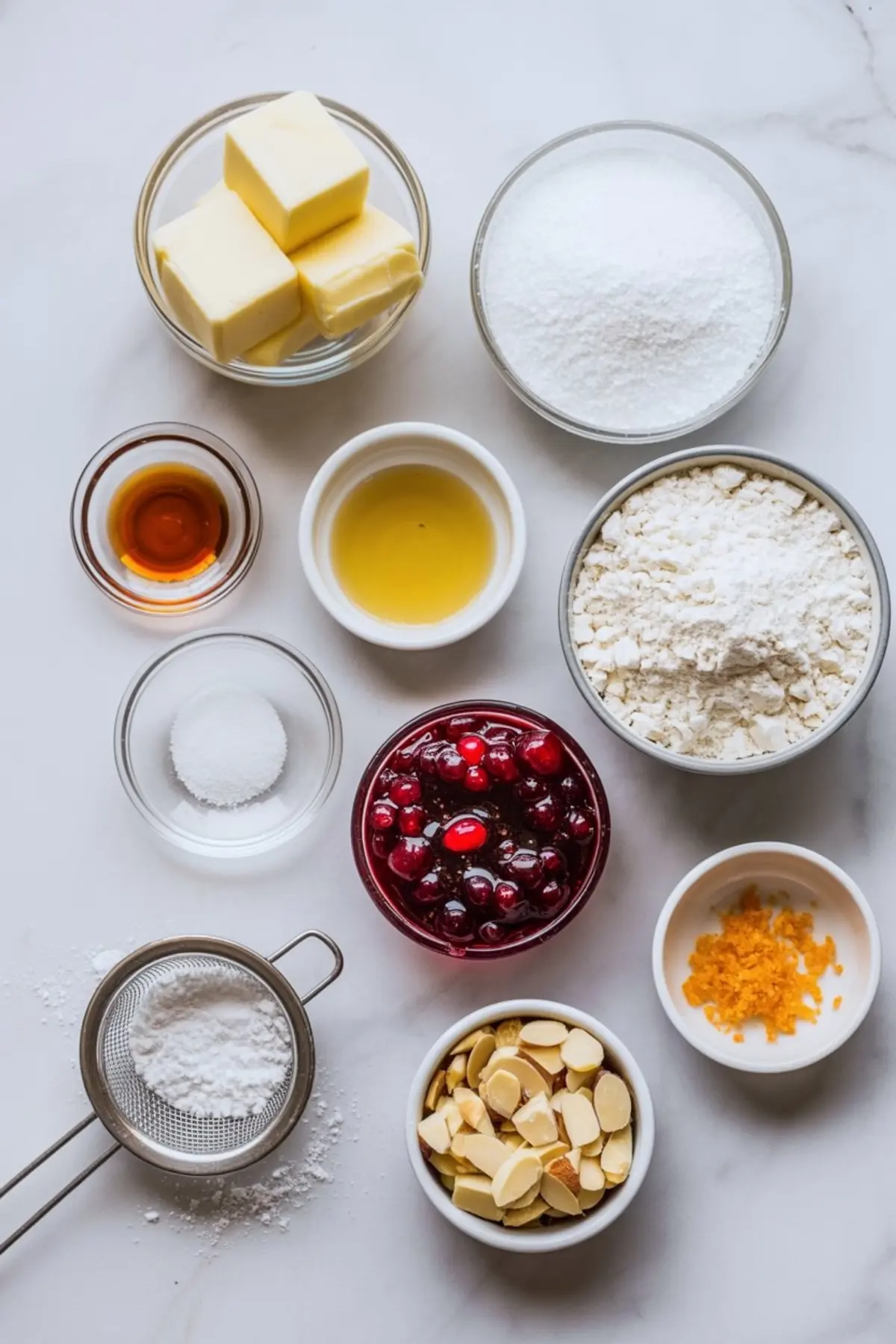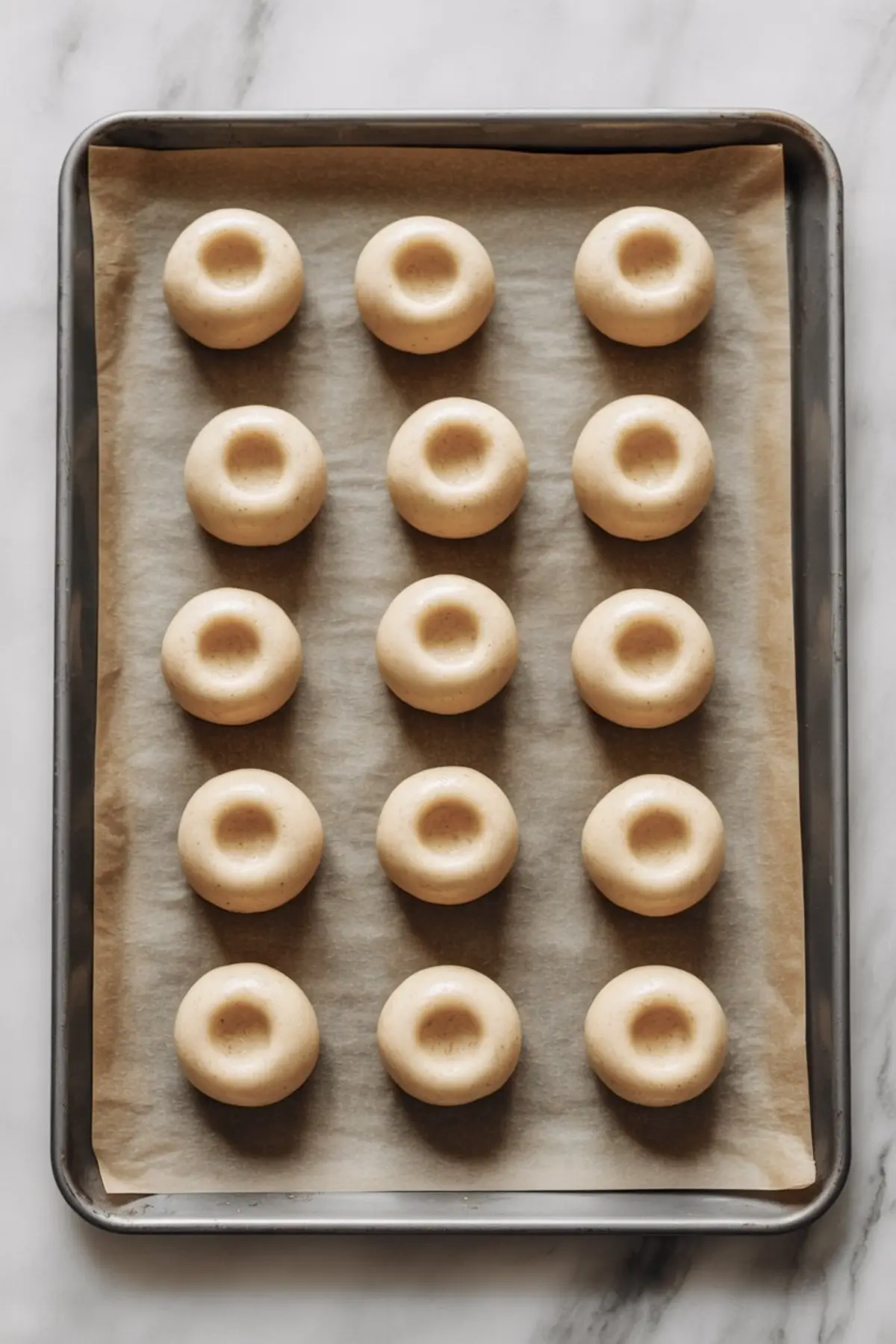There are thumbprint cookies that melt into mush, and then there are thumbprint cookies that hold their shape without turning dry. These Cranberry Almond Thumbprint Cookies belong to the second group. You’ll be working with a shortbread-style dough flavored with almond and vanilla, then filling each well with tart cranberry sauce and topping them with sliced almonds for a little crunch.
In this article, you’ll learn why each ingredient choice matters, how to shape the cookies to avoid cracking, and how to adjust the dough texture if you live somewhere warm or cold. You’ll also get one practical ingredient comparison between all-purpose flour and almond flour so you can decide which way to go based on how soft or structured you want your cookies.
This thumbprint cookies recipe is meant to bring ease, not guesswork. If you’ve ever struggled with jam cookies spreading too much, or going stale by day two, I’ll show you how to avoid both.

The Buttery Base That Binds It All

Softened unsalted butter forms the heart of this dough. I use two sticks, which might sound indulgent, but it’s what creates that melt-in-the-mouth texture. The butter must be soft, not greasy. If it’s too warm, the cookies won’t hold their thumbprint. You’ll notice the dough holds together like clay but still feels light to the touch. That’s when you know it’s right.
Granulated sugar gives sweetness and structure without overshadowing the almond. It also helps the dough brown gently, which matters when baking delicate shapes like these.
I’ve tried versions of these cookies with brown sugar and didn’t love the outcome. The extra moisture changed the crumb too much, and the flavor began to pull away from the almond.

Vanilla and Almond Extract, Why Both?
Vanilla gives warmth. Almond gives identity. Using just one leaves the flavor flat. I go with half a teaspoon of each so they balance. Almond extract can turn sharp if overdone. This ratio keeps it present but soft.
Why All-Purpose Flour Over Almond Flour?
Here’s where things get interesting. I’ve tested this recipe with both flours. Almond flour gives a more delicate, slightly crumblier texture and intensifies the almond flavor. But it also makes the dough looser, which means it spreads more during baking and doesn’t hold the thumbprint as clearly.
All-purpose flour gives more control. It allows the cookie to keep its shape while still staying tender. If you want a structured cookie for holiday platters or gifting, go with all-purpose flour. If you’re baking for yourself and prefer a softer bite, substitute 1/4 cup of the flour with almond flour, but don’t go beyond that unless you adjust the rest of the recipe.
Shaping the Cookie Without Cracking the Dough
I always recommend rolling the dough into smooth balls, then pressing a well with your thumb or the back of a measuring spoon. If the dough starts to crack around the edges, it’s likely too cold. Let it sit for a minute or two at room temperature before shaping.
Space the cookies about two inches apart. They won’t spread wildly, but they need a little breathing room.
Here’s another tip from my notes press the well gently, but go deep enough to hold a decent spoonful of filling. Shallow impressions lead to runoff during baking.
If you’re experimenting with other holiday cookies too, these Christmas Thumbprint Cookies use a similar dough and offer a vibrant raspberry twist.
Filling with Cranberry Sauce and Orange Zest

This part’s flexible. I use whole berry cranberry sauce because it gives texture. The orange zest is optional, but I recommend it. It brightens the filling and cuts the sugar with a little citrus.
You can use homemade cranberry sauce or a good store-bought one. The trick is not to overfill. A half-teaspoon per cookie works. It will spread slightly as the cookie bakes and settles.
Another fun variation you can try during the season is our Santa Claus Cookies—they follow a completely different structure but are just as festive.
Almond Topping and Baking to Golden Edges
Sliced almonds go on just before baking. Press them lightly into the dough so they stick. They toast as the cookies bake and add that nutty finish that plays against the tart filling.
I bake these for 13 to 15 minutes at 350°F. They’re done when the edges start turning pale gold. Not brown. Just barely golden. If they look done in the oven, they’re likely a minute too far.
Let them cool on the tray first. Then move to a wire rack. That step keeps the base from going too soft underneath.
If you enjoy holiday cookies with unexpected flavor touches, my Raspberry Linzer Cookies offer a shortbread-like dough with a spiced jam center worth exploring.
Powdered Sugar or Not? Here’s My Take
I used to skip the powdered sugar entirely. I thought it looked too sweet or overdone. But for these, I changed my mind. The dusting makes them feel finished, especially when stacked on a tray. Wait until they’re fully cooled before dusting. If the cookies are warm, the sugar melts instead of sitting pretty.
If you’re working ahead, freeze the shaped, unbaked cookies and fill them fresh. That way, you get the texture right without worrying about soggy centers.
Storage Notes That Actually Help
These cookies keep well for about five days in an airtight container. They soften slightly after day two, but the flavor holds strong.
If you want to freeze, I recommend freezing the cookies unfilled. Once thawed, add the cranberry filling and bake fresh. This preserves both texture and color.
Looking for another wintry bake to pair with this one? Try Winter Wonderland Chocolate Chip Cookies for a snowy look and a classic feel.
Pin This and Share Your Version With Me

If you’re baking for the holidays, pin this recipe so you don’t lose track. I’ve baked these cookies every year since 2016, and every batch brings something slightly different. That’s what makes it worth coming back to.
If you try these Cranberry Almond Thumbprint Cookies, let me know how they turned out. Did you add the zest? Did you go with almond flour or stick to the original? I’d love to hear your version in the comments.
Let’s make this a space where baking questions are welcome and wins are shared.
Cranberry Almond Thumbprint Cookies

These Cranberry Almond Thumbprint Cookies are a festive classic made with soft buttery cookie dough, flavored with almond extract and filled with sweet-tart cranberry sauce. Each thumbprint is topped with sliced almonds and finished with a dusting of powdered sugar for a bakery-style touch. This easy thumbprint cookies recipe uses simple pantry ingredients like flour, butter, and sugar, with optional orange zest for a citrusy holiday twist. A delicious addition to your list of holiday cookie recipes, cranberry cookies, or jam cookies, these cranberry thumbprint cookies are perfect for Christmas trays, cookie exchanges, or weekend baking!
Ingredients
- FOR THE COOKIE DOUGH
- 1 cup (2 sticks) unsalted butter, softened
- 2/3 cup granulated sugar
- 1/2 teaspoon almond extract
- 1/2 teaspoon vanilla extract
- 2 1/4 cups all-purpose flour
- 1/4 teaspoon salt
- FOR THE FILLING
- 1/2 cup cranberry sauce (homemade or store-bought, preferably whole berry)
- 1 tablespoon orange zest (optional but recommended)
- FOR TOPPING
- 1/4 cup sliced almonds
- Powdered sugar, for dusting (optional)
Instructions
- MAKE THE DOUGH: In a large mixing bowl, cream the softened butter and granulated sugar together on medium speed until the mixture is light and fluffy, about 2 to 3 minutes. Add the almond extract and vanilla extract, mixing until fully incorporated. Gradually add the flour and salt, mixing on low speed until a soft dough forms. The dough should be pliable and hold together without being sticky. If needed, add a teaspoon of milk if too dry, or chill for 15 to 20 minutes if too soft.
- SHAPE THE COOKIES: Preheat the oven to 350°F (175°C) and line two baking sheets with parchment paper. Scoop and roll the dough into 1-inch balls and space them about 2 inches apart on the prepared sheets. Use your thumb or the back of a teaspoon to press a small well into the center of each ball, being careful not to press all the way through.
- FILL AND BAKE: In a small bowl, combine the cranberry sauce with the orange zest, if using. Spoon about 1/2 teaspoon of the cranberry mixture into each well, taking care not to overfill. Press a few sliced almonds lightly onto the tops of each cookie. Bake for 13 to 15 minutes, or until the edges are just turning golden. Allow the cookies to cool on the baking sheet for 5 minutes before transferring them to a wire rack to cool completely. Dust with powdered sugar once fully cooled, if desired.
Notes
Store cookies in an airtight container at room temperature for up to 5 days. For longer storage, freeze unfilled cookies and fill after thawing. Almond extract gives the cookies their signature flavor—do not substitute without adjusting for taste.
Nutrition Information
Yield
28Serving Size
1Amount Per Serving Calories 149Total Fat 7gSaturated Fat 4gTrans Fat 0gUnsaturated Fat 3gCholesterol 18mgSodium 24mgCarbohydrates 20gFiber 0gSugar 11gProtein 1g

